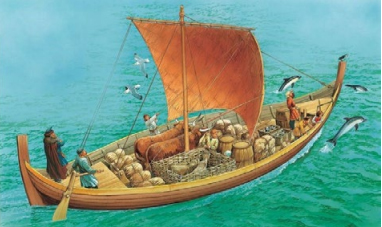
| - | - | - | - | - |
| Dungeons & Dragons | - | Dragon magazine | - | The Dragon #12 |
Variety in the types and amounts of treasure can often enhance the
enjoyment of Dungeons and Dragons.
On the high seas, an encounter
with an alien merchant ship leads
to a brisk battle, after which the victorious
party examines the cargo hold to determine their booty. This
captured treasure can turn out to be either highly valuable or next
to
worthless. The following outline was developed for a voyage to Japan
<link=aerth/nippon.htm>
which was never completed (although the characters involved passed
off Nubian slaves as captured Japanese peasants).
Cargo can only be determined after grappling and surrender or
annihilation of enemy forces. Small merchant ships can hold up to
12 units of cargo, while large merchant ships can hold up to 30
units. Roll a d6 for each kind of treasure possible; each roll of
a one means that there are from one to six units of that particular
type
of cargo on board. If the total number of units of cargo is greater
than
the capacity of the ship, neglect the least valuable cargo.
| Cargo | Value per Unit Gold Pieces | Comments |
| Spice | - | - |
| Silk | 1000 | - |
| Precious Stones | 1000 | Amber, flint, jade, marble, emeralds, etc. |
| Ivory | - | - |
| Precious Wood | 300 | Only 1-4 units; ebony, teak, balsa, etc. |
| Tea | 350 | - |
| Cotton | 250 | - |
| Jewelry | 1000 | This is primitive and low-grade stuff, not the jewelry used in normal D&D campaigns. |
| Cloth | 250 | - |
| Livestock (exotic) | 250 | Camels, falcons, peacocks, monkeys, ocelots, Arabian horses, etc. |
| Fruits and vegetables | 100 | Spoilage may occur, especially over long voyages. |
| Foreign slaves | - | 20-60 people |
Also, roll for treasure — type A.
There is also a 15% chance that a few passengers are aboard ship.
These passengers can be merchants, adventurers, or noblemen.